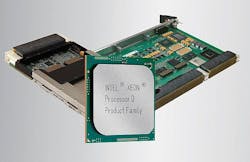Military embedded computing dominated by Intel microprocessors; NXP, ARM, Nvidia also in mix
Of these three, Intel clearly is dominant, Qualcomm NXP (formerly Freescale), occupies application niches, and Nvidia is an up-and-coming supplier -- particularly where massively parallel processing is involved for high-performance embedded computing (HPEC).
One future up-and-comer for military embedded computing might be the ARM architecture, which microprocessor designers license from ARM Holdings plc in Cambridge, England. "Arm architectures are starting to be talked about in embedded applications," says Mike Slonosky, senior product manager for ARM and Power architectures at the Curtiss-Wright Corp. Defense Solutions Division in Ashburn, Va. "Our feeling is we will see more of that, although we aren't seeing it yet."
Intel dominance
Intel today is the most dominant microprocessor producer for aerospace and defense embedded computing. The company makes a range of processors for a variety of applications, ranging from high-performance processing on the high end to power-efficient processors for mobile or wearable applications.
The Intel Core i7 combines general-purpose processing with an on-board general-purpose graphics processor (GPGPU) to help with parallel processing for aerospace and defense applications like digital signal processing in radar, electronic warfare (EW), and signals intelligence (SIGINT).
For applications that require power efficiency over the highest possible performance, Intel offers versions of the Atom, which is optimized for mobile applications that must be able to run for as long as possible on battery power. Atom is one solution from Intel that may stave-off competition from the ARM processor.
Niche applications
Qualcomm NXP, with headquarters in Eindhoven, The Netherlands, and U.S. operations in Austin, Texas, manufactures the venerable Power Architecture microprocessor family.
"NXP processors essentially are for control-type systems," Slonosky says, as well as for mission computers that require more determinism and control loops than other microprocessors. Legacy VME single-board computers still make broad use of the Power architecture.
Nvidia GPGPUs typically are considered specialty processors like ASICs and FPGAs, but increasingly are considered to be general-purpose processors, says Marc Couture, product manager at Curtiss-Wright Defense Solutions. "In the past, and even in the present the GPU has been this side-car super accelerator, yet the internal architecture and GPGPU software are becoming more and more suitable to go after the general purpose processing."
Company information
Advanced Micro Devices Inc. (AMD)
Sunnyvale, Calif.
www.amd.com
ARM Holdings plc
Cambridge, England
www.arm.com
Intel
Santa Clara, Calif.
www.intel.com
Microsemi
Aliso Viejo, Calif.
www.microsemi.com
Nvidia Corp.
Santa Clara, Calif.
www.nvidia.com
Qualcomm NXP
Eindhoven, The Netherlands
www.nxp.com
Texas Instruments Inc.
Dallas
www.ti.com
Learn more: search the Aerospace & Defense Buyer's Guide for companies, new products, press releases, and videos
